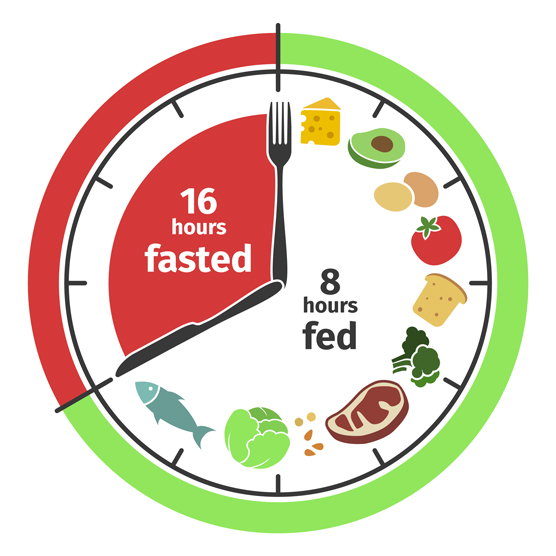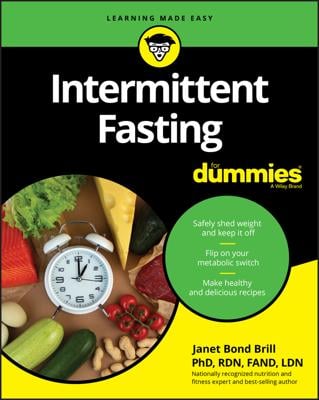Time-restricted intermittent fasting means you limit your eating and fasting periods to a set number of hours every day — hence, the name the eating window. The most common time-restricted pattern is the 16:8 intermittent fast, which is where you eat all your food for the day in an 8-hour period — eat as often as you wish during this window. The remaining 16 hours is your fasting period where no calories are consumed (only calorie-free beverages and lots of water). You repeat this exact pattern daily.
 © Leyasw / Shutterstock.com
© Leyasw / Shutterstock.comAlthough there are numerous variations to the time-restricted intermittent fasting plan, this article focuses on the intermittent fasting 16:8 plan and provides advice on how to follow it. This article also tells you all you need to know about when to eat and when to fast.
What is time-restricted intermittent fasting?
Most people eat from the time they wake up until the time they go to bed. When you practice time-restricted eating, you basically limit the number of hours you eat in a day. The popularity of this form of intermittent fasting lies in the fact that when you switch from the traditional style of eating (three meals and snacks) to time-restricted eating, you’ll naturally eat less calories and lose weight — no counting calories, no restricting favorite foods — hence easier than old-fashioned dieting. Those people who are unsuccessful with this type of fasting are those individuals who allow themselves to cram all their typical calories into their eating window.Time-restricted intermittent fasting is a type of plan that limits your food intake to a certain number of hours each day — your eating window. You choose the most sustainable time frame and hours that work best for your lifestyle. This plan isn’t a license to binge eat any and everything you want during your eating window. The goal for weight and fat loss is still to create a daily calorie deficit (you eat less calories on a daily basis than you used to).
Although the 16:8 is probably the most common and the easiest plan for you to start with, other intermittent plans, including the 17:7, 18:6, and 20:4 are options you can choose. Here, I specifically discuss the 16:8 intermittent fasting plan, how it works, and see if this is the intermittent fast you want to start following today.Try the 16:8 time-restricted plan
The 16:8 intermittent fasting is quite effortless and the simplest plan for you to start with. With the 16:8 plan, you restrict eating to an 8-hour window such as 10 a.m. to 6 p.m. and fast 6 p.m. to 10 a.m. the following day. The 16:8 intermittent fast was first popularized by Martin Berkhan with his book The Leangains Method.With the 16:8 time-restricted intermittent fasting plan, you choose the 8 hours when you eat all your calories and continue that pattern daily. The 8-hour eating window is the most lenient of all the intermittent fasts, because the 8-hour time frame gives you a wide eating latitude compared to other time-restricted eating patterns. Plus, you can easily map out the eating window hours in your day that most coincide with your work and social activities. You could start today and simply move breakfast to 10 a.m. and stop eating at 6 p.m. — whatever works for you!
If your goal is weight loss, you want to be sure that the number of hours you eat is less than what you typically allow yourself. In other words, if you’re used to eating over a 10-hour period, you want to ensure that you reduce your eating window to much less (the lower, the better). If you have good results with the 16:8 or you’re more ambitious, you can reduce your eating window, which can range from 4 to 12 hours a day, mean 16- to 20-hour fasts.
Why the 16:8 plan is easy
The 16:8 plan is popular because it’s a more conservative time-restricted feeding protocol than all the other forms of intermittent fasting. In fact, this eating pattern is much more like a normal eating pattern than other intermittent fasting plans. Many people even adhere to this eating pattern unintentionally; it translates into a pattern of skipping breakfast and not eating after dinner each day. The 16:8 method is also popular for beginners because people typically sleep for about half of the 16 fasting hours.To clarify, people lose weight following time-restricted intermittent fasts because by restricting eating windows to less than before, they automatically eat less calories on a daily basis. The concept is, if you restrict the amount of time you can spend eating, you’ll eat less food than you used to. If you make up for the missed meals by overindulging during your eating windows, you will not lose weight.
Consider this example of a person following the 16:8 time-restricted intermittent fasting: John’s goals are to stay healthy and fit and lose some body fat. Before John, 45, began intermittent fasting, he normally ate his first meal at 8 a.m. and kept eating (and drinking) until around 10 p.m. He therefore ate all his food in a 14-hour window each day. John decided to begin a time-restricted intermittent fast, so he reduced this eating window number (the number of hours he consumed food each day) to an 8-hour eating window. He found it easiest for him to only eat during a window of 8 hours (repeating the same 8-hour window day in and day out), which essentially removed two of his meals or snacks.John revised his schedule by starting eating at noon and stopping eating at 8 p.m. — a time frame that worked best for his work and family schedules. Plus, he continued with his daily cardio workout first thing in the morning, practiced rhythmic relaxation breathing exercises for 5 minutes just before lunch, and squeezed a strength-training workout in — twice a week — just after work. John followed this plan for six months and lost 5 pounds of body fat plus reduced his fasting blood sugar level to less than 100 mg/dl, lowered his LDL cholesterol, and raised his HDL cholesterol numbers.
Lose the fat and keep the muscle
The best way to lose the fat and not your muscle mass that you have worked so hard to gain is to continue your regular strength-training workouts during your time-restricted fasting plan.Make sure to get consent from your personal physician before you engage in an exercise program, especially exercise combined with intermittent fasting.
If you’re a fit and muscular person and are following a time-restricted intermittent fast to garner the health benefits, maintain your lean body mass, and lose some body fat, then I have some good news — some sound scientific data supports the effectiveness of this strategy.A study out of Italy looked at the effect of putting resistance-trained, lifetime steroid-free athletes on an 8-week program of 16:8 time-restricted fasting. Thirty-four muscular, fit men (average age 30 years old) were divided into two groups: the regular diet and the 16:8 diet. Both groups of men continued their regular weight-training routines. During the 8-week experimental period, the 16:8 subjects consumed 100 percent of their calories (daily calories calculated to maintain current body weight) divided into three meals consumed at 1 p.m., 4 p.m., and 8 p.m., and fasting for the remaining 16 hours per 24-hour period. The control group ingested their caloric intake (calculated to maintain current body weight) as three meals consumed at 8 a.m., 1 p.m., and 8 p.m.
The results? Both groups maintained their same level of muscle mass. However, only the 16:8 group showed significant health and body composition gains. The intermittent fasters lost a sizable amount of body fat (2-1/2 pounds) and reduced their bodies’ level of inflammation. Furthermore, only the intermittent fasting group showed a decrease in blood sugar and insulin levels. Importantly, the fasting group also demonstrated a significant increase in adiponectin levels.
Adiponectin is a hormone produced and secreted exclusively by adipocytes (fat cells). Adiponectin functions to regulate the metabolism of fats and blood sugar. In humans, blood levels of adiponectin are significantly lower in people with insulin-resistance and type 2 diabetes. The increase in adiponectin and decrease in insulin levels seen in the 16:8 intermittent fasting group is due to the ability of intermittent fasting to increase insulin sensitivity — a well-known effect of increased adiponectin levels. Moreover, adiponectin has an anti-inflammatory effect that led to the reduction of inflammatory markers seen in the fasting group.
A key point of the time-restricted fasting approach utilized in the study was that total daily calorie intake remained the same in both groups, with only the time between meals altered for the fasting group. The mere timing of food affected body composition and health markers. Time-restricted intermittent fasting with 16 hours of fasting and 8 hours of eating is a beneficial training strategy for resistance-trained athletes to improve health-related biomarkers, decrease fat mass, and at least maintain muscle mass. Bodybuilders could adopt this kind of regimen during their maintenance phases of training, commonly referred to as cutting, in which the goal is to maintain muscle mass while reducing fat mass.How much is too much
After you decide on a specific daily eating period, what and how often should you eat? That depends on your goals. If you’re partaking in intermittent fasting to lose weight, then you must ensure that your eating period doesn’t turn into an eat-everything food fest. For weight loss, the primary reason for its success is that intermittent fasting helps you eat fewer calories overall. If you binge and eat massive amounts during your eating windows, you probably won’t lose any weight at all and may even gain some.A common initial side effect of starting an intermittent fasting program includes feeling hungry and irritable, also known as being hangry. You’re probably familiar with the feeling; you’re hungry and growing hungrier with every passing minute. Your hunger is making you increasingly unpleasant to be around, upset, irritable, angry. You are hangry!
Understand that you can control these feelings. The good news is that they usually pass after two weeks to a month as your body and brain become accustomed to this new lifestyle. During your hours of fasting, try to consume plentiful amounts of noncaloric beverages, such as water, black coffee, and tea as well as eating nutritious foods during your eating windows. Doing so will take the edge off your appetite and help prevent you from becoming hangry.Visualizing a time-restricted fasting plan — a sample 1-week calendar
Choose the eating window that works best for your lifestyle, make your own calendar, and start now to begin your life-enhancing intermittent fasting journey. This less drastic type of time-restricted intermittent fasting may be a good choice for you as a newbie. It’s fairly easy to follow and many people find it the most doable plan for their lifestyle. A sample 1-week 16:8 intermittent fasting plan
A sample 1-week 16:8 intermittent fasting planI suggest you start with 16:8 for the first few weeks. After you have some success, you may consider increasing your fasting window (go with 18 hours of fasting and 6 hours of eating). Regardless of the amount of time you choose for your eating window and your fasting window, remember to keep your fasting goal and feasting goals in mind.

